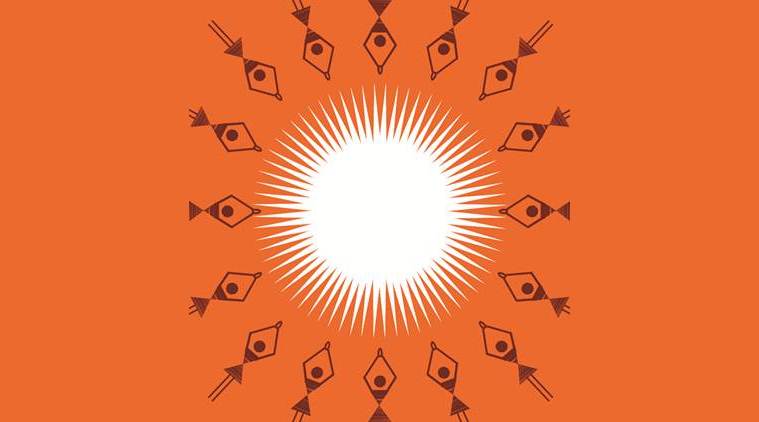 “For long, blatant anti-Hinduism flourished under the garb of the grand Nehruvian secularism project. L K Advani’s Rath Yatra in September 1990 marked the beginning of the end of this kind of toxic secularism.” (Illustration by C R Sasikumar)
“For long, blatant anti-Hinduism flourished under the garb of the grand Nehruvian secularism project. L K Advani’s Rath Yatra in September 1990 marked the beginning of the end of this kind of toxic secularism.” (Illustration by C R Sasikumar)
In December 2017, the Science Channel — a part of Discovery Inc. — released a short video clip analysing the land bridge connecting India and Sri Lanka based on scientific evidence. The video clip released on Twitter claimed that the bridge, known to Hindus as the Ram Setu (the bridge of Lord Rama), was man-made. The short video has geologist Alan Lester, a professor at the University of Colorado, Boulder, Erin Argyilan, a professor in the Department of Geosciences at Indiana University Northwest, and others discussing the fact that the sandbar between the two nations is natural and that the stones covering the sandbar have been brought from far and set on top. Practising Hindus would know that this incident is described in the Yuddha Kanda of the Ramayana — the army of Rama, the Vanara Sena, created the bridge after writing the Lord’s name on the rocks.
India does not need Western academicians to validate the scientific nature of Hindu beliefs. However, this matter is significant owing to the stance of the then Congress-led UPA government. In an affidavit submitted to the Supreme Court in September 2007, to dismantle the Ram Setu so that the Setusamudram shipping canal project could be built, the UPA government stated that “… mythological texts, which formed an important part of ancient Indian literature … cannot be said to be historical records to incontrovertibly prove the existence of the characters or the occurrence of the event.” In this case, the UPA misused the Archaeological Survey of India (ASI) to further its agenda and deny the existence of Lord Rama so that they could deny the existence of the Ram Setu in the process. Thanks to consistent pressure from the Sangh Parivar, this affidavit was later withdrawn. The Director of Monuments in the ASI, who had signed the affidavit in the Supreme Court, later stated that the affidavit was prepared by the Ministry of Law and Justice and he was asked to sign it.
The idea of secularism was good on paper as long as its practitioners believed it served the purpose of separating the affairs of the state from religion. However, within a few years of the creation of the republic, it became a tool that was used to either guilt-trip the majority religion or to eke out disproportionate concessions from them. Over time, Nehruvian secularism descended into what it truly stood for — naked anti-Hinduism. Although this transition to rank anti-Hinduism seems like a recent development, the origins can be traced back to as early as 1951 with the reconstruction of the Somnath Temple.
The decision to reconstruct the Somnath Temple was made by Sardar Patel and others immediately after Independence, in November 1947. Gandhiji favoured the reconstruction, but wanted it to be funded through public donations and contributions with the Union government playing no role in its reconstruction. Prime Minister Jawaharlal Nehru found this initiative to be revivalist. He vehemently opposed the move and when he heard that President Rajendra Prasad would be participating in the event to install the deity in the temple in May 1951, he wrote several letters to dissuade him from doing so.
Two aspects become clear from Prime Minister Nehru’s letter to the President: First, the deep discomfort in a Hindu civilisation taking pride in its past and taking steps to revive it and second, the mocking of Hindu rituals and practices such as the request to embassies of other countries to collect twigs and water for the consecration of the temple. While in his letter to the President, the Prime Minister terms the act of collecting water and twigs as rash, in the notes to the Foreign Secretary and others, he terms it as fanciful and asks embassies to not entertain such requests.
The arguments that were made during the Somnath consecration are used even today. Some public intellectuals opine that only a specific type of public good should be built whenever activities to reconstruct temples are initiated. Little do they understand that temples are actually public goods, owing to the philanthropic activities they undertake and the sense of community that they instil.
This brings us to the event early this month.
The Prime Minister and chief ministers of various states have been invited for the Bhumi Pujan of the grand temple for Lord Rama at his birthplace in Ayodhya on August 5. The PM’s decision to attend this event bears significance as it sets the tone for us to discuss and debate the full truth regarding the repressive regimes of the past and the attempts made to wipe out and destroy symbols dear to Hinduism.
Many Opposition leaders do not want an honest debate and hence have been asking the prime minister to refrain from attending this event. For long, blatant anti-Hinduism flourished under the garb of the grand Nehruvian secularism project. L K Advani’s Rath Yatra in September 1990 marked the beginning of the end of this kind of toxic secularism. The symbolism of August 5, 2020, should signify the death of this kind of fake secularism — where one community bears the brunt of a project that was created to prevent them from uniting its people. Let the return of Lord Rama in Ayodhya bring light to all, especially to those ignorant souls who revel in creating narratives and barriers to prevent a religion from staking claim to what was rightfully hers.
The writer is the Minister of State for Home Affairs, and a Member of Parliament from Secunderabad constituency